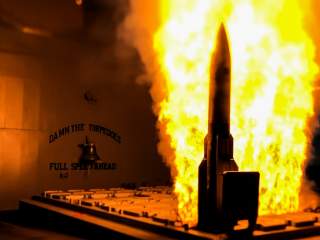Does the U.S. Navy Want Out of the Missile Defense Game?
"Ten years down the road, it’s time to build something on land to defend the land. Whether that’s Aegis Ashore or whatever, I want to get out of the long-term missile defense business and move to dynamic missile defense."
The U.S. Navy's frustration with the static missile-defense mission seems to be shifting Pentagon planning. It's possible the U.S. Defense Department could establish more land-based missile-defense sites in order to free up warships for flexible deployments.
A Feb. 6, 2019 report from the Congressional Research Service neatly summarizes the controversy.
As of late 2018, the Navy possessed 38 destroyers and cruisers with the Aegis radars and software and Standard missiles for detecting, tracking and shooting ballistic missiles. The ships carry a combination of SM-3 missiles for hitting rockets above the atmosphere and SM-2 and SM-6 missiles for intercepting them in the atmosphere.
The Navy wants to equip as many as 60 warships for ballistic missile defense, or BMD, by 2023. At least 30 of the ships would escort aircraft carriers in order to protect them from missile attack.
Eleven would be in reserve in the United States. Nine would be in Japan for short-notice deployments in the Pacific region and to support standing missile-defense patrols keeping watch for North Korean attacks. Four would be in the Mediterranean, ready to intercept any rockets Iran launches toward the United States.
In 2018, the Navy kept a total of six ships on missile-defense patrol at all times near Japan and in the Med. Those six vessels were a source of frustration for the fleet, Chief of Naval Operations Adm. John Richardson said.
"Right now, as we speak, I have six multi-mission, very sophisticated, dynamic cruisers and destroyers―six of them are on ballistic missile defense duty at sea," Richardson said in June 2018 at the U.S. Naval War College’s Current Strategy Forum. "And if you know a little bit about this business you know that geometry is a tyrant."
"You have to be in a tiny little box to have a chance at intercepting that incoming missile," Richardson added. "So, we have six ships that could go anywhere in the world, at flank speed, in a tiny little box, defending land."
Richardson practically pleaded with policymakers to replace standing BMD patrols with land-based missile-defense sites. The Pentagon operates Aegis Ashore sites -- in essence, Aegis sensors and SM-3 launchers installed in a building -- in Poland and Romania. Japan also is building its own Aegis Ashore systems.
Building more, similar installations could free up the cruisers and destroyers to roam, Richardson said. "Ten years down the road, it’s time to build something on land to defend the land. Whether that’s Aegis Ashore or whatever, I want to get out of the long-term missile defense business and move to dynamic missile defense."
Bryan McGrath, a former destroyer captain who is now a consultant with The FerryBridge Group, rejected Richardson's reasoning. "The BMD mission is part of what creates the force structure requirement for large surface combatants," McGrath wrote.
"Absent it, the number of [cruisers] and [destroyers] would necessarily decline. This may in fact be desirable, depending on the emerging fleet architecture and the roles and missions debate underway. Perhaps we need more smaller, multi-mission ships than larger, more expensive ones."
"But it cannot be forgotten that while the mission is somewhat wasteful of a capable, multi-mission ship, the fact that we have built the ships that (among other things) do this mission is an incredibly good thing," McGrath added. "If there is a penalty to be paid in peacetime sub-optimization in order to have wartime capacity -- should this not be considered a positive thing?"
In late 2018 Richardson briefly seemed to drop his public appeal for fewer standing missile-defense patrols. "My guess is the CNO got snapped back by the Pentagon for exceeding where the debate actually stood," one naval expert commented.
But then Richardson revived his argument at a January 2019 event at the Brookings Institution. "We’ve got exquisite capability, but we’ve had ships protecting some pretty static assets on land for a decade,” he said. “If that [stationary] asset is going to be a long-term protected asset, then let’s build something on land and protect that and liberate these ships from this mission."
In early 2019 there was evidence Richardson's plea finally was having the result he intended. The Pentagon's January 2019 Missile Defense Review proposed converting a land-based missile-defense test site in Hawaii into an operational system, potentially freeing up some of the Pacific missile-defense ships.
The Defense Department "will study this possibility to further evaluate it as a viable near-term option to enhance the defense of Hawaii," the review stated.
If the Pentagon does establish more land-based missile-defense sites, the Navy soon could find itself with a more flexible fleet of destroyers and cruisers. Ships could sail wherever they're most needed, rather than steaming in figure-eight patterns off the coasts of Spain or Japan for months at a time, waiting for Iran or North Korea to fire a rocket.
David Axe serves as Defense Editor of the National Interest. He is the author of the graphic novels War Fix, War Is Boring and Machete Squad.


